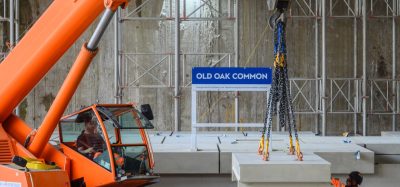Ballast Reinforcement: a new vision or just a mirage?
Posted: 8 April 2008 | | No comments yet
Despite modern railways being at the forefront of technologies such as power transmission, signalling, control systems and vehicle dynamics, there is one element which is stuck firmly in the Stone Age – the trackbed. It is true that some tracks are being designed and built with concrete or asphalt bases, but for good economic reasons, the overwhelming majority of railways are set to remain bedded in stone.
Despite modern railways being at the forefront of technologies such as power transmission, signalling, control systems and vehicle dynamics, there is one element which is stuck firmly in the Stone Age – the trackbed. It is true that some tracks are being designed and built with concrete or asphalt bases, but for good economic reasons, the overwhelming majority of railways are set to remain bedded in stone.
Despite modern railways being at the forefront of technologies such as power transmission, signalling, control systems and vehicle dynamics, there is one element which is stuck firmly in the Stone Age – the trackbed. It is true that some tracks are being designed and built with concrete or asphalt bases, but for good economic reasons, the overwhelming majority of railways are set to remain bedded in stone.
Ballast stones can give excellent performance of course; they combine a reasonable degree of deformation resistance with the useful property that they can be reworked when necessary – i.e. tamped – but it is undeniably highly desirable to increase the deformation resistance if at all possible. Major routes in the UK typically need tamping at least once a year. This is a fact of life; it is our inheritance, a direct consequence of the railway construction methods of the mid 19th Century.
Ballast movement and geogrid action
Since individual ballast stones are not bound into any matrix, movement inevitably occurs. In extreme cases, passage of a high-speed train can actually ‘suck’ individual stones into the vortex of disturbed air, creating a significant nuisance – e.g. crushing stones under the wheels. Under more normal conditions, stones will simply slip over each other as a train axle passes and then slip back when it has gone. However, not all will slip back fully; around the sleepers, where stresses are at their highest, some will slip and never return, and the cumulative result is sleeper settlement, always accompanied by differential settlement since not all sleepers will be equally well supported – and differential settlement means poor ride quality.
The aim is therefore clear: sleeper settlement must be reduced if at all possible. If neither cement nor bitumen is to be used to bind the individual stones together as in a concrete or asphalt base, then the next best thing is to put up barriers to inhibit stone movement. This, in effect, is what a geogrid does. It prevents the stones immediately around it from rearranging themselves. They can still slide and slip as a train load passes, but the geogrid will tend to pull them back into their original positions much more efficiently than would otherwise be the case; and if one layer of stones is prevented from rearrangement the next layer will also find it difficult; and the next; and the next. That, at least, is the theory.
Practicalities
It is unrealistic to expect that geogrid reinforcement can ever eliminate settlement completely, and future tamping must therefore be possible. Furthermore, the geogrid cannot of course prevent ballast fouling, which means that future ballast cleaning should also be permitted. For these excellent reasons, it is impractical to place the geogrid any higher than approximately 300mm beneath the sleepers. One then has to consider the practicalities of installation. In a new or completely reconstructed track this is no problem and it is standard practice in several European countries to include geogrid reinforcement within the sub-ballast layers; in an existing track however it is a very serious issue. One obvious solution would be to install the geogrid during a ballast cleaning operation, perhaps an unusually deep ballast cleaning operation, and this has been successfully undertaken in the past. There is sufficient space between the cutter chain on a ballast cleaner and the return path for clean ballast stones to allow a roll of geogrid to be inserted and unrolled. A standard roll width is 4m, which is just about right for a single railway track.
One way or another, therefore, it can be done – but is it effective?
Research
Between 2004 and 2007, a major research project was undertaken at the University of Nottingham, funded primarily by the Royal Society, on the subject of ballast reinforcement using polymer geogrid (Figure 1 on page 86). The project involved both physical tests and computational work, using an advanced computing technique known as ‘discrete element modelling’ (DEM). Initial practical experiments were simple repeated load tests of ballast, with or without a geogrid, in a large box through a sleeper-width loading plate using an artificial (rubber) substrate. A number of different geogrid types were tested, including a welded steel mesh. Some gave clear benefit; others didn’t; some even made matters worse! In the end, the following key conclusions emerged from this phase of the research:
- The optimum geogrid aperture size was found to be about 60-70mm, a little larger than the ballast dimension. This was the clear conclusion both from testing and from DEM modelling of detailed geogrid-ballast interaction (Figure 2)
- Geogrid stiffness in bending is important. This was illustrated by excellent early performance given by steel mesh reinforcement (Figure 3), as well as the relative results for different weights of polymer geogrid
- The detailed shape of the geogrid rib is also important. Despite the good early performance of steel mesh, sleeper settlement failed to slow in the way observed with polymer geogrids, and this was attributed to the circular cross-section of the steel bar, compared to the angular shape of polymer geogrid ribs
- Surprisingly, the effectiveness of the geogrid was almost independent of the depth at which it was included, although this was only checked over the depth of the ballast layer itself. This research did not cover the practice of reinforcing the sub-ballast, which has clear and measurable effects in terms of sub-ballast tests, and would theoretically inhibit movement within the ballast to some extent
Overall, the level of improvement found was sufficient to warrant fuller investigation. This was achieved in a new Railway Test Facility (Figure 4), in which three full-size sleepers were placed on a complete trackbed comprising of ballast overlying about 0.8m of a silty clay soil. Loading was applied to the sleepers at the rail seat locations in a phased manner to simulate the passage of a train, although no rail was actually present. The sleeper load used was 9.5 tonnes, equivalent to an axle load of about 25 tonnes, taking into account the way the rails spread the load between sleepers. Figure 5 on page 89 shows the results of two tests, with and without a polymer geogrid, and the clear finding from the series as a whole was that, with the right geogrid, the rate of development of settlement was at least halved, even with the geogrid at a depth of 300mm, immediately overlying a geotextile placed over the soil.
Live trials
As the first results from the research emerged, Network Rail became increasingly interested and a trial site was found on the West Coast Main Line in Lancashire. This was a site requiring renewal, where soft subgrade problems combined with a seriously fouled ballast had required frequent maintenance over a number of years. The site comprised five (eighth mile) sections and it was decided that two should be reconstructed with a geogrid at the bottom of the ballast, while three would not. In fact, subsequent testing showed that the two geogrid-reinforced sections actually had the least stiff subgrade.
The renewal was carried out in September 2004. Figure 6 on page 89 reveals the performance of the track before and after in terms of its standard deviation (SD) from a moving 35m datum, the standard means of expression of track evenness in the UK. Clearly, all sections had much improved SD following renewal but the key features with regard to reinforcement are:
- The initial SDs of reinforced sections were slightly lower than those of unreinforced sections following renewal, despite these sections having had the highest SDs prior to renewal. In fact, the post tamping minimum SD of 0.6mm is very unusual on UK track
- Since renewal, there is no clear distinction between the performances of reinforced and unreinforced sections. However, this is despite the reinforced sections having poorer subgrade and a poorer previous history
Where to go from here?
The research seems pretty clear; geogrid reinforcement really does produce benefits, although these benefits are yet to be fully quantified. If the proportional reduction in settlement rate, reflected in a reduction in differential settlement (SD) on a live railway, were to lead (on average) to a halving of the number of tamping operations, then one could begin to quantify the savings. The direct saving per year would amount to half a tamping operation – a relatively modest figure, but then the secondary benefits have to be added in. Many studies have come to the conclusion that tamping is one of the principal causes of ballast breakdown, and reduced tamping frequency therefore means reduced ballast breakdown, which means longer intervals between ballast cleaning operations. Perhaps of most significance, less maintenance activity means less disruption to operations and less potential for lapses in safety.
The benefits, though still subject to evaluation as further experience is gained, have certainly been sufficient to persuade Network Rail in the UK to use ballast reinforcement. The research described here resulted directly in a rewriting of UK guidance and it is estimated that some 10% of renewals now use the new geogrid reinforced ballast specification – mainly sites with particular historical problems. An open question remains: should the technique be used more generally? Laboratory tests suggest that some benefit accrues even when the subgrade is relatively stiff, since the reinforcement still inhibits movement within the ballast. It would surely be sensible to check this out on a number of sites; the value or otherwise should be quite clear within a relatively short time simply by inspecting the rate at which track unevenness increases and this can then be fed directly into an economic analysis. Trackbed maintenance is such a costly activity that anything which achieves a significant percentage saving is most definitely worth pursuing.
About the author
Dr. Nick Thom
Dr. Nick Thom lectures in railway engineering at the University of Nottingham, as well as acting as a consultant to UK engineering firm Scott Wilson. His background is principally in highway engineering. He is part of a team at the University of Nottingham researching trackbed deterioration mechanisms, ballast degradation and geogrid reinforcement.







